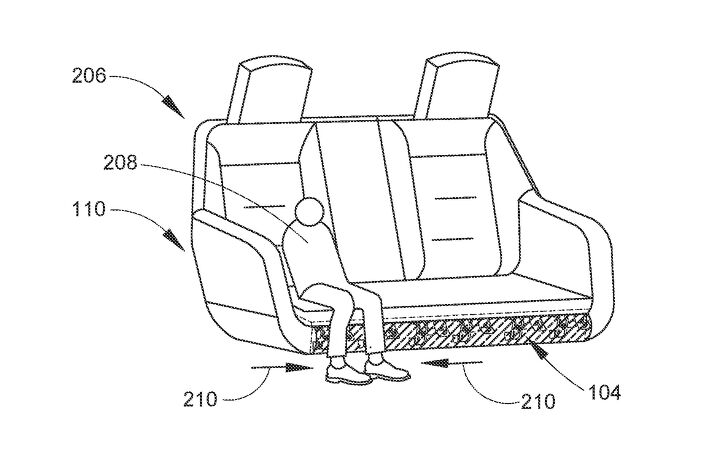Honda Patents Seats With Shock Absorption

Modern car seats are notoriously uncomfortable. We can blame manufacturers for cutting costs while seeking to standardize snazzier equipment elsewhere. Buyers often don’t consider the importance of seat comfort, especially when they’re only spending 10 minutes on a test drive. However, worsening road conditions have made us long for prior decades when car companies went overboard with the springs and foam.
The industry knows this and the phenomenon may even help explain the popularity of crossover vehicles, which often have softer suspensions than their sedan counterparts. But Honda is working on something that would bring the buffering inside the cabin.
According to a report from CarBuzz, the Japanese automaker has filed a patent with the United States Patent and Trademark Office for shock absorbers mounted directly to the seat frame. It’s basically a secondary suspension just for the seating and is designed to help smooth out any bumps the external springs couldn’t handle.
Though the system also seems to be designed to help minimize injuries during a serious accident as well.
From CarBuzz:
Honda specifically points to body regions like the tibia and elbow being affected in a discomforting manner. With additional shock absorbers as part of the seat frame, however, the remaining impact load can be absorbed before it unsettles occupants.
Honda repeatedly references "collisions" in the patent documentation, but we presume this doesn't only involve serious crashes, but also when the wheels strike bumps, hit objects like rocks and potholes in the road, or traverse rougher terrain. However, the company also stated that the seat shock absorbers could help cushion occupants in the event of a more serious collision with another car or a tree. This makes sense due to the forces that our bodies are subjected to in a crash, when the main point of contact is with the seat.
"In certain cases, during severe collisions of obstacles against the vehicle, the external shock absorbers may partially absorb the impact load and transmit the remaining impact load to the occupant compartment," says the description of the device. "The bracket located in the occupant compartment may absorb the remaining impact load that may not be dampened by the external shock absorbers."
The associated documentation is primarily about how these shock absorbers would mount to the vehicle frame using brackets. Everything else is basically there to make the explanation as broad as possible for the sake of legal protections, as “suspension seats” already exist. But Honda’s unit would function differently.
Rather than having an embedded webbing of springy textile materials designed to keep your tailbone from being destroyed while off-roading, the patented shock absorbers are separate from the seat itself. Based on the USPTO filing, the flat and rounded surfaces are connected by brackets and designed to redirect the load.
On smaller bumps, they’re supposed to create a smoother ride by evening out harsh vibrations. When exposed to a serious impact, the bracket itself is intended to warp as a way to help minimize the forces being inflicted upon passengers. Since the moment should be minimal the system is intended to be used with airbags — assuming Honda decides to implement it.
[Images: USPTO]
Become a TTAC insider. Get the latest news, features, TTAC takes, and everything else that gets to the truth about cars first by subscribing to our newsletter.

Consumer advocate tracking industry trends and regulations. Before joining TTAC, Matt spent a decade working for marketing and research firms based in NYC. Clients included several of the world’s largest automakers, global tire brands, and aftermarket part suppliers. Dissatisfied, he pivoted to writing about cars. Since then, he has become an ardent supporter of the right-to-repair movement, been interviewed about the automotive sector by national broadcasts, participated in a few amateur rallying events, and driven more rental cars than anyone ever should. Handy with a wrench, Matt grew up surrounded by Detroit auto workers and learned to drive by twelve. A contrarian, Matt claims to prefer understeer and motorcycles.
More by Matt Posky
Latest Car Reviews
Read moreLatest Product Reviews
Read moreRecent Comments
- Ajla IMO, something like this really should be naturally-aspirated.
- Kjhkjlhkjhkljh kljhjkhjklhkjh Unless they are solid state batteries you BAN THEM. I like EVs... but EVs like to burn ... for days
- Kjhkjlhkjhkljh kljhjkhjklhkjh uh .. it looks like a VW golf got the mumps
- Kjhkjlhkjhkljh kljhjkhjklhkjh I CANNOT WAIT FOR SOCIAL SECURITY TO GET GUTTED.. No i am really serious. I am insulated thanks to 24 years at Symantec then Broadcom .. tons of retirement cash. but all the blue hairs and low income trump voters are going to lose benefits and jobs and i get to laugh allllll dayyyyy long in about 2-3 years.. CANNOT WAIT, POPCORN READY.
- Kjhkjlhkjhkljh kljhjkhjklhkjh no. to many '''''americans'''' just want a CUV or SUV according to sales numbers





































Comments
Join the conversation
Ironically, the best vehicle seats I've experienced were the hardest. The first new car I owned, a '78 Audi Fox, had seats upholstered in a tan velour, with very firm foam, with a nice ergonomic shape, including built-in lumbar support. The velour was also pretty grippy, which helped hold you in place in cornering.
i have found seats in my last 3 vehicles progressively more in comfortable after being in them 45 minutes. The last time. I experienced comfort was in a 98 Camry xle.